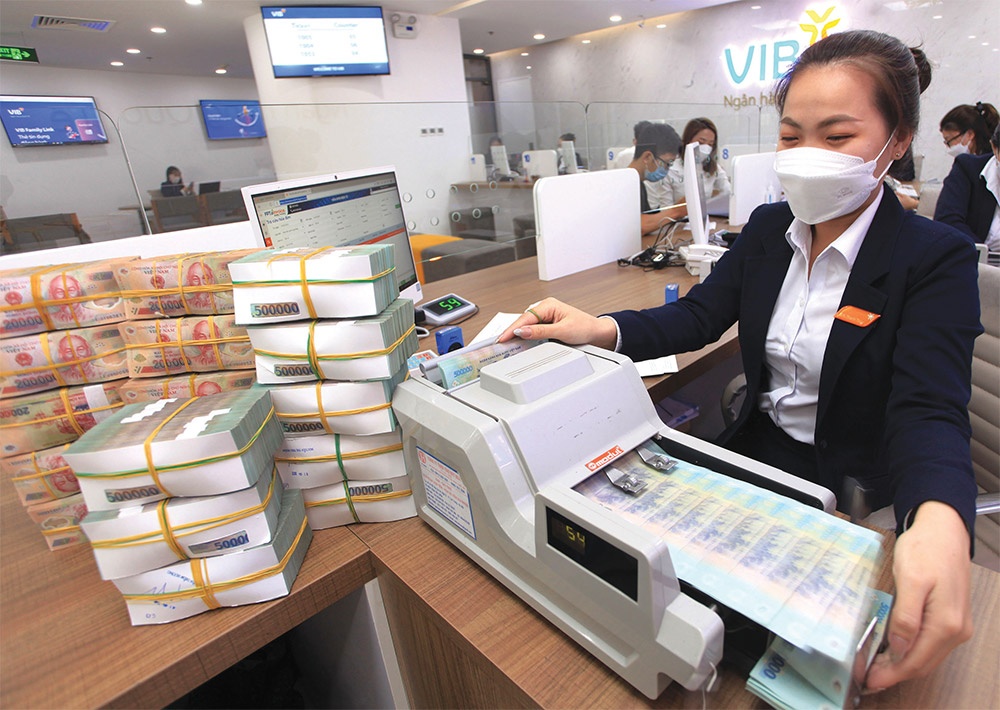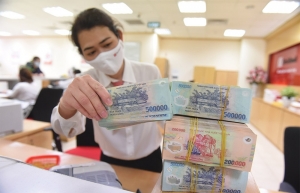Policies could pump in more credit in H2
At a conference hosted by VIR in late July on the investment opportunities in H2, Citibank Vietnam shared GDP growth figures of Vietnam in the second quarter, which increased to 6.93 per cent on-year, from 5.7 per cent in the first quarter. Looking ahead, Citibank has raised its forecast for Vietnam’s GDP growth in 2024 from 6 to 6.4 per cent.
 |
| The central bank is expected to maintain a stable exchange rate Photo: Le Toan |
According to the State Bank of Vietnam (SBV), credit growth in the first six months reached 6 per cent, higher than the 3.36 per cent increase in the same period of 2023, thanks to the recovery of exports, investment activities, and consumption. It is forecasted that credit growth will exceed 15-16 per cent for the entire year.
On this growth foundation, Dr. Le Xuan Nghia, a member of the National Monetary and Financial Policy Advisory Council, made predictions about Vietnam’s monetary policy for the H2.
“Monetary policy will continue to be accommodative and flexible to reduce lending rates for businesses in both manufacturing and real estate markets. In the latter half of the year, policies of debt extension, deferral, and maintenance for enterprises will continue to pump credit into the economy,” Nghia said.
The SBV will maintain a stable exchange rate and significantly reduce the gap between domestic and international gold prices, he added.
“Although these measures are not yet fully sustainable, they initially show positive effects in bolstering the confidence of both domestic and international investors in the government’s ability to control the macroeconomy, as approved by the National Assembly, aiming for inflation under 4.5 per cent, the devaluation of VND under 5 per cent, and stable liquidity in the banking system,” said Nghia.
Fiscal policy continues to improve, especially with actual state budget revenue exceeding projections, reaching $36.06 billion in the first half of the year, equating to 58.2 per cent of the annual target, 15.3 per cent higher than the same period last year, according to the General Department of Taxation.
Dat Tong, senior Market Strategy manager at Exness Investment Bank, said the upcoming US election and the slow economic recovery in China are two risks that could change Vietnam’s macroeconomic information in the latter half of the year.
“Also, market participants predict that the Federal Reserve will cut interest rates about 2-3 times this year. Europe and the UK will also see interest rate cuts by the end of the year, while Japan has a roadmap for rate hikes. This will cause changes to exchange rate pairs,” he added.
Assessing the macroeconomic situation, Tran Tuan Tai, investment director of SonKim Retail, commented that the government and ministries are doing well in stabilising interest rates and supporting the economy, despite ongoing global pressures.
“Experts predict that the US Federal Reserve will cut rates one or two times between now and the end of the year. The first cut is expected to be 25 basis points. When the Federal Reserve cuts rates, it will reduce exchange rate pressure on Vietnam, allowing us to fully expect foreign capital to continue returning to the country, reducing exchange rate pressure and improving the economy and investment activities of financial institutions across various sectors,” said Tai.
From a broader perspective, economic expert Dr. Nguyen Tri Hieu said that Vietnam’s economic outlook will continue to be optimistic for the second half if the Fed decides to cut rates, reducing exchange rate pressure, inflation, and positively impacting other macro balances. Conversely, if it delays cuts, many disadvantages are predicted for Vietnam’s economy, including increased exchange rates, inflation, and adverse impacts on foreign investment.
“However, given the international and domestic situations mentioned, we can expect macroeconomic stability to be maintained, large balances to be ensured, and business and public confidence to be reinforced. Vietnam’s economic growth in the second half of the year is likely to reach 6.3-6.8 per cent, and for the entire year, it could achieve 6.3-6.5 per cent,” added Hieu.
 | Banks remain wary of low credit growth Overall weak credit demand in the market, with consumption growth still sluggish, is causing banks that do not meet their credit growth targets to have quotas proactively transferred by the State Bank of Vietnam (SBV) to banks with better capabilities. |
 | Revision forces banks to reveal more shareholders The new regulations of the revised Law on Credit Institutions, made effective a month ago, aim to curb the influence of affiliated entities on banking operations. |
What the stars mean:
★ Poor ★ ★ Promising ★★★ Good ★★★★ Very good ★★★★★ Exceptional
Related Contents
Latest News
More News
- Vietnam’s corporate bond market set for a more positive 2026 (January 15, 2026 | 14:10)
- Foreign sentiment towards Vietnam turns more positive (January 15, 2026 | 11:08)
- Wealth management faces skills gap as investor confidence lags (January 13, 2026 | 10:23)
- HDBank completes $100 million international green bond scheme (January 12, 2026 | 16:28)
- Vietnam’s IPO market eyes revival in 2026 (January 09, 2026 | 17:28)
- Brokerage competition tightens as market shares narrow (January 09, 2026 | 15:19)
- Banks set for selective hiring in 2026 (January 08, 2026 | 10:56)
- Pilot digital asset exchanges to be licensed by mid-January (January 08, 2026 | 10:38)
- Banks step up debt recovery to support earnings (January 08, 2026 | 10:34)
- Finance sector was key pillar of 2025 growth (January 07, 2026 | 08:00)

 Tag:
Tag:




















 Mobile Version
Mobile Version